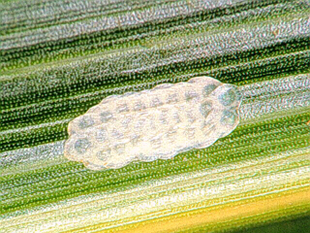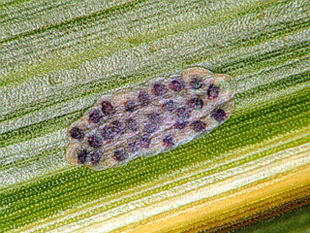G1783
Second Generation European Corn Borer Scouting and Treatment Decisions
The decision to treat for European corn borer is complex and affected by many variables such as weather, plant maturity, borer survival and development, anticipated corn prices, insecticide efficacy, and costs versus anticipated returns. This publication discusses the factors growers need to consider when assessing the need for control of second generation European corn borers in non-Bt corn.
Robert J. Wright, Extension Entomologist
Fields having green silks and shedding pollen during the peak period of moth flight are most susceptible to second generation European corn borer infestation. To determine the need to control second generation European corn borers, begin scouting when the second flight of moths appears, usually in mid-July. Scout fields regularly, at least once every three to five days, especially during the early half of the moth flight period. Select a minimum of 50 plants per field, choosing plants from several different parts of the field. Examine the underside of leaves for white borer egg masses (Figure 1). These masses, usually found on leaves in the middle third of the plant (frequently near the midrib), normally hatch in about five days. Each egg develops a black spot just before hatching (Figure 2).
 |
 |
|
| Figure 1. European corn borer egg mass (UNL Department of Entomology). | Figure 2. Black head stage European corn borer egg mass (UNL Department of Entomology). |
Application timing is critical for reasonable control. Best control (approximately 50-70 percent, depending on timing, application method, and product choice) is realized when application is timed to first significant egg hatch and when young larvae still are located in the leaf axils. Larvae that have bored behind the leaf axil, into the sheath or are in or on the ear unlikely will be controlled. As the plant approaches blister stage and beyond, potential economic benefits of an insecticide application rapidly decline.
The following worksheet can help determine whether treatment of second generation European corn borers in corn is economical. For this worksheet you need to know:
- Average number of egg masses per plant in field
- Crop stage
- Expected yield
- Expected value of corn
- Expected percent control with insecticide
- Cost of control (product plus application costs)
This worksheet will be useful in closely evaluating the many factors influencing the cost/benefit relationships involved in treating second generation European corn borers. Average values are suggested in the worksheet and may need to be modified in certain situations:
- Borer survival is suggested to be three borers per egg mass. On average, European corn borer egg masses contain 20 eggs, although this may vary from 10 to 40. Three borers per 20 eggs equals a 15 percent survival rate. Larval survival will vary with weather conditions and field type (dryland versus irrigated). In irrigated corn, larval survival is likely to be 20 percent or more, but in dryland corn, it’s likely to be 10 percent or less. Exposure to hot, dry weather greatly decreases egg survival.
- Yield loss per borer is suggested to be 4 percent per borer for infestations before silks turn brown, and 3 percent per borer after silks turn brown, but before blister stage. These values account only for physiological yield loss (reduced yield from corn borer damage to water and nutrient uptake through the stalk) and do not consider the potential for yield loss due to stalk breakage or ear drop.
- Percent control with insecticides is suggested to be equal to 70 percent. This is a good average value for second generation European corn borer control, although if your data suggests higher or lower control levels under your conditions, change this value.
The best control that can be achieved usually will prevent much of the stalk and leaf sheath tunneling, but will not necessarily prevent invasion of the ear tip. This is especially true if the borer flight period is extended or a partial third generation occurs. Stalk protection is critical for the plant to fully develop the ear. While late worms that attack the ear tip do reduce grain quality, they do not reduce yields as seriously as borers that tunnel in stalks. Early harvest and selection of a corn variety that has good ear retention should minimize ear drop.
Generally, liquid and granular formulations of the same insecticide are equally effective against second generation European corn borer larvae. However, if other insects (except spider mites) are present and/or European corn borer moth numbers are high, liquid formulations are preferred over granules because of their broader spectrum of activity and the added advantage of obtaining some moth control. If spider mites are present, select an insecticide that is least likely to contribute to rapid increases in mite numbers.
Use the following worksheet to determine whether it is profitable to treat for second generation European corn borer. In the example, the field has a yield potential of 150 bushels per acre, corn value is assumed to be $3 per bushel, one egg mass per plant is found in green silk stage corn, and the cost of insecticide and its application totals $12 per acre.
Resources
European Corn Borer Ecology and Management. 1996. C.E. Mason et al. North Central Regional Extension Publication 327, Iowa State University, Ames.
Handbook of Corn Insects. 1999. K.L. Steffey et al. (eds.). Entomological Society of America. For ordering information, see http://www.entsoc.org/pubs/books/handbooks/index.htm
Acknowledgment
Modified from Second Generation European Corn Borer Scouting and Treatment Decisions, NF365, by R.J. Wright and J.F. Witkowski, University of Nebraska–Lincoln Extension.
Management Worksheet for Second Generation European Corn Borers |
||
An online version of this worksheet is available at http://entomology.unl.edu/fldcrops/index.shtml |
||
| Example | Your estimates | |
| Number of egg masses per plant x 3 borers per egg mass* = borers per plant |
1 egg mass per plant x 3
= 3 borers per plant |
|
| Borers per plant x 4% yield loss per borer** = percent yield loss |
3 x 4% = 12 % yield loss |
|
| Percent yield loss x expected yield (bu per acre) = bushels per acre loss |
12% x 150 bu per acre = 18 bu per acre |
|
| Bushels per acre loss x sale price ($/bu) = $ potential loss per acre |
18 bu/acre x $3/bu = $54 |
|
| $ loss per acre x 70% control*** = $ preventable loss per acre | $54 x 70%
= $37.80 |
|
| $ preventable loss per acre – $ cost of control (product + application costs) = $ profit (+) or loss (-) per acre if treatment is applied |
$37.80 – 12.00 = $25.80 |
|
If preventable loss exceeds cost of control,
insecticide treatment likely will result in economic benefit. |
||
| *Assumes survival rate of three borers per egg mass; may vary with weather and egg mass size.
**Use 3 percent loss per borer per plant if infestation occurs after silks are brown. The potential economic benefits of treatments decline rapidly if infestations occur after the corn reaches the blister stage. ***70% is an average, use another value if desired. |
||
This publication has been peer reviewed.
Visit the University of Nebraska–Lincoln Extension Publications Web site for more publications.
Index: Insects & Pests
Field Crop Insects
2007, Revised November 2013